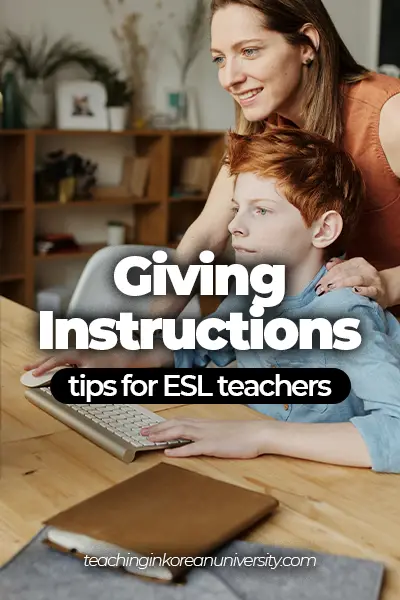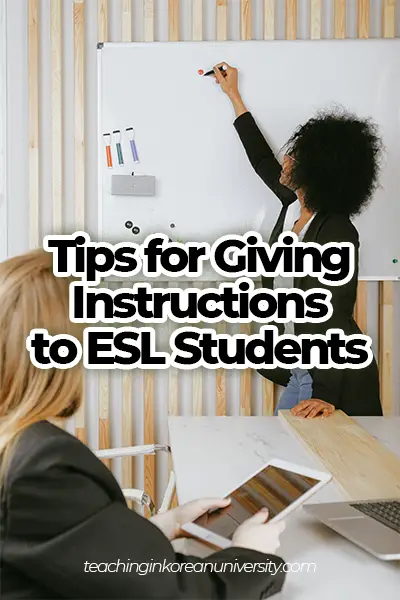What is the best way to give instructions to students whose first language is not English? Is slowing down and making sentences simple the way to go? Would that also be a good strategy for mature ESL students? If not, is it better to give students some time to struggle and figure out what it means on their own? If you are wondering about these kinds of questions and are looking for the answers, you are definitely at the right place. We have the best tips for giving instructions that will be especially useful for ESL teachers.

Giving Instructions: Tips for ESL Teachers
Tips for Giving Instruction to ESL Students
Now, let’s get to the point. Check out the list of the best tips and tricks for giving better instructions. These tips can be applied to reading, speaking, writing, and listening ESL classes!
#1: Wait for students to be ready before giving instructions
One of the biggest mistakes teachers will often make is that they give instructions before students are ready to listen. Remember, ESL students will not understand 100% of what you are saying even when they are fully focused. So, how much better can their comprehension be if they are not focused or ready to listen? It can be frustrating for teachers but be patient, stay calm, and please wait until everyone is seated and ready to listen to the teacher.
Also, if the entire class doesn’t concentrate, you will have to give the same instructions multiple times to different students in the same class. That’s tiring! Make your life and your students’ lives easier by waiting for everyone to be quiet and seated.
Good rules to make in a classroom:
- class doesn’t start until everyone is seated
- class begins once the class is silent
- only one person speaks at a time
#2: Use more than one instruction method
Giving instructions verbally is fine. This can work perfectly most of the time. However, at times, you will want to use other methods when giving instructions. For example, use PowerPoint presentations that have slides that have bulleted points that sum up what you are saying. Students will understand the important points even if they don’t pick them up from your verbal explanation.
Also, give handouts. You don’t have to do this for every single class. However, if you are giving projects or assignments that have detailed instructions, you should give handouts in some form. It’s better to have a handout that students can refer to when completing the assignment.
#3: Check if your students understood
A lot of teachers end an instruction by asking students, “got it?” or “do you think you can do it?” and “did you understand it?” The problem with these questions is that most of the students will answer ‘yes’ even when they actually don’t. If you really want to check if your students understood your instructions, use ICQs. Continue reading for ICQ examples and how you can implement them in your classroom.

How to Give ESL Students Good Instructions
#4: Limit the number of instructions
Don’t give too many instructions at once. You don’t want to overload students with too much information. Remember that it’s the task that should be the challenge, not the instruction itself.
Information overload can be overwhelming for anybody, not just ESL students.
#5: Keep it simple when giving instructions
Yes, your ESL students will have to get used to reading and understanding instructions. However, don’t make the instructions challenging. Keep them as simple as possible. Use lists, bulleted points, shorter sentences, and visuals. The real challenge should be the assignment, quiz, project, or other activities, and the instructions are there to guide the students.
#6: Make eye contact with students when giving instructions
It can be challenging for teachers to write on the board, speak, and make eye contact with students all at the same time. Perhaps, it’s almost impossible! Even if you try to do it, you will end up writing on the board while speaking and not looking at your students.
You have something to write on the whiteboard? Awesome. Go ahead and do so! But when you want to talk, turn around and speak to your students while looking into their eyes. Your students will concentrate way better this way.
#7: Speak slowly when giving instructions
Slow down when you speak. ESL students, especially beginners, will have a hard time understanding what the teacher says, even the most simple things. So, it can be even harder to comprehend when the teacher is giving instructions for a challenging activity or assignment. Speak slowly. Pause in between sentences.
These pauses are great opportunities for you to look at the class and see if they are understanding what you are saying. If not, you’ll probably be able to see the confusion on their faces. While speaking nonstop, you may not be able to catch these non-verbal cues.
#8: Give examples when giving insturctions
When you give instructions, also give examples. It doesn’t matter what the task is, provide some examples. Sometimes, good examples are much more helpful than super detailed instructions. People say, a picture says a thousand words, right? It really does! Spend a few minutes going over the instructions, and use 1-2 minutes to show examples. If it is an activity that requires students to work in groups or pairs, find a volunteer to do a shorter example version of the activity with you.
#9: Instruction Checking Questions (ICQ)
If you did the CELTA and DELTA English teacher certification course, you might be familiar with ICQ, which stands for Instruction Checking Questions. Remember I told you to stay away from asking, “did you get it?” or “do you understand it?” after giving instructions? Replace those questions with ICQs.
ICQs are basically open-ended questions that check if students really understood the teacher’s instructions.
Examples of ICQs:
- How many times do you have to repeat the dialogue?
- How do you choose the winner?
- If you do x, what happens to y?
- How many sentences do you have to write?
- What are the three most important rules?
- What is the topic of your sentences?
- How many people do you have to ask the questions?
#10: Concept Checking Questions (CCQ)
CCQ stands for Concept Checking Questions. It is the same idea as ICQs, but you are checking if ESL students understood the concept instead of the instructions. When I say concept, it means things like grammar or vocabulary.
For example, if you taught comparative adjectives, you could ask these kinds of CCQs
- Who is taller, Jim or Tommy?
- Who is stronger, Keith or Bob?
Depending on your lesson type, you could use both CCQs and ICQs!

Tips for Giving Instructions to esl students
FAQs About Giving Instructions to ESL Students
Here are some of the most commonly asked questions about giving instructions to ESL students.
What are the 4 basic steps in giving out instructions?
The four basic steps in giving instructions: show the material, instruct the task, check your instructions, and hand out materials.
What are things to remember when giving instructions?
Some of the key tips when giving instructions are: wait for students to be ready, use a variety of instruction methods, check if students understood with ICQs, make eye contact, speak slowly, and give examples.
What does ICQ stand for in teaching?
ICQ stands for Instruction Checking Questions. ICQs are specific questions that are meant to check if students actually understood the instructions. “Did you understand?” is not an example of ICQ because it doesn’t effectively check students’ understanding. A good example of ICQ is, “How many times do you have to repeat the dialogue with your partner?”
Tips for Giving Instructions: Join the Conversation
What are your thoughts on the tips for giving instruction to ESL students? Which tip will you try in your classroom? If you know a cool tip or trick for giving instructions, let us know in the comments. We’d love to hear from you!




